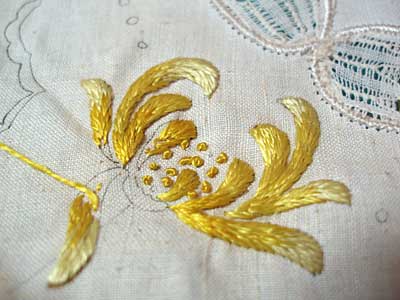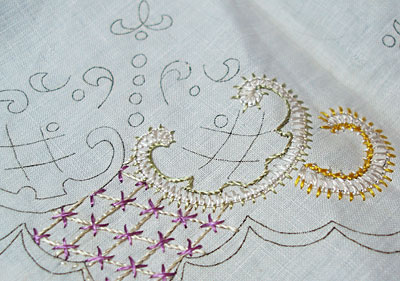Last August, I showed you a wonderful collection of Society Silk (aka Silk Art Embroidery or Needlepainting) pieces that I received from a reader, along with a bunch of threads that belong to this historical embroidery movement that spanned the end of the 1800’s through the beginning of the 1900’s. This morning, I found an informative comment from Donna Cardwell, author of the book Silk Art Embroidery and the website (which is now defunct) The Society Silk Embroidery Collectors Club.
The comment that Donna left on the original post about Society Silk Embroidery is well worth reading, so I wanted to highlight it here, since last year’s August article is probably pretty obscure right now.

Society Silk (or Silk Art Embroidery) was an embroidery style popular from the mid 1880’s into the second decade of the 1900’s. On her website, Donna narrows the dates down to 1877-1912. The style featured typical Victorian designs, especially of flowers and vines and so forth, stitched with silk on linen in long and short stitch. The technique was taught to women in America in order to give them a source of income. You can read all about the history of the technique at the Society Silk Embroidery Collectors Club website.

In my original article on the Society Silk pieces I received, I wondered about a few things: the difference in types of linens, the types of threads, whether or not the linens would wash up. Donna was kind enough to supply the following extensive answer to my musings:
Hi Mary, what lovely pieces. I was just wondering what you decided to do with them as far as washing the spots out. My experience has been that the pre-printed designs were made to wash out in the first wash ~ I don’t think they will still be there if you try to immerse them in anything resembling soap and water (or even just plain water).
In my research for my book (Silk Art Embroidery, A Woman’s History of Ornament & Empowerment), I purchased many, many pieces just like this that had been worked but never washed, and you could still see the design under the floss. When soaked, the design comes right out.
As far as the patterns themselves, the ladies could purchase the linens to be worked with the design already stamped; buy a Stamping kit and either copy the patterns from the many embroidery books; or they could design their own pattern and stamp them on whatever type of linen they wished. Some of the companies also offered them for sale at a higher price with the embroidery already started, which could explain the partly done embroidery on some of your pieces.
You are correct that the pieces could be purchased with the drawnwork and/or hemstitching already done. This was especially true of the smaller fine white linen teacloths that were so popular for teatime. I have several catalogs from which dealers actually purchased their stock of items to sell, and there are many different types of pieces such as this.
Also, the difference in the fabric and the designs is because in the beginning of the silk art embroidery movement in America (in 1877), fine white linen was the norm for most of the table linens. Closer to the end of the approximately 33-year period (1877 to 1910-1912 or so), they began to use the coarser, heavier fabric. They called the different fabrics “ticking,” “brown burlap,” “grey crash,” “Tan Art Cloth,” to name a few. The designs also turned away from the pure realism of the beginning time period to include more abstract “Arts & Crafts” and “William Morris” type motifs. In many cases, these linens were also shaded so that the volume of embroidery necessary to finish the piece was much less then from years past. Often they only worked the edges of these designs.
Also, they offered MANY different types of floss and the motifs look totally different when worked with differnt types ~ Richardson’s sold “Filo,” “Sicilian,” “Grecian,” “Rope Silk,” “Wash Embroidery Twist,” “Honiton Silk” (especially for use in Honiton Lace work), or “Mountmellick Silk.” There are also different sizes of silk floss for different types of items ~ something that was used on the table had to be more sturdy, while a piece made to frame (which came into popularity in 1901) could be a little less sturdy and therefore more delicate floss could be used.
Ecclesiastical embroidery was very popular as mentioned, and though I’ve seen many patterns in the embroidery books, I’ve only seen one piece in real life (which I found after my book was published, so it’s not in the book). I’ll post a picture of it on my website if you would be interested in seeing it.
By the way, many of your pieces have the very popular motif of maidenhair ferns stamped on them. Also, all of these are table linens. It was very common to purchase them in sets for the whole table. They consisted of a centerpiece and matching doilies.
Hope some of this helps. If I can answer any more questions, please feel free to contact me. You can do so through my website.
You’ll find Donna’s website (now defunct – 2013) Society Silk Embroidery, an informative and beautiful resource for those interested in this period and type of embroidery. Do stop by there and visit! And thank you, Donna, for the informative comment!







Wow Mary~! I really enjoyed all the information in this post. I think I have a few pieces that might qualify as Society silk! Loved hearing all the details and history. Thank you!
So enjoyed this article! How wonderful to know that there is a Society dedicated to preserving the embroidery of this bygone era.
The quality of the stitching in the photos on Donna's site is simply amazing. Makes me realize I have a long way to go…
-Sharon
Dear Mary
I fund Your Web site a few weeks ago and I really like it.
I live In Poland, where most popular is cross stitch. In some regions people knows other embroidery techniques like Bobbin lace, embroidered white, richelieu, Irish lace. But we have so many types of embroiders in the world. I like Goldwork – like You. In Poland just several people familiar with this technique.
I’m going to look You site, because it is very inspirational for me.
Good look with next embroiders.
Best regards
Anna from Poland
Thanks Mary,
How fascinating! However, I shuddered at the mention of "Mountmellick silk". I would not want anyone to think that working Mountmellick embroidery in silk was the right thing to do! This would have been a marketing attempt to sell more thread, and nothing more. You see, Mountmellick Embroidery (from the town of Mountmellick, in Ireland) was worked on white cotton satin jean in white matt cotton thread. The thread was supposed to be *cotton* and *not shiny*! Silk is neither of these things!
Interesting that the silk manufacturers were trying to make it otherwise, but this was certainly NOT a traditional way of working Mountmellick, so I wouldn't want anyone to think so.
While I love Mountmellick embroidery and I love working with silk, I keep those two loves separate. 🙂
Yvette Stanton
Author of "Mountmellick Embroidery: Inspired by Nature"
http://www.vettycreations.com.au/me.html
I'm always ready for a visit to Society Silk land. I am so grateful to Donna for giving me a name to call this type of embroidery!
I have a fantasy where I find a piece of about 110 year old beautiful fine linen stamped with a wonderful design all ready for me to stitch! Even better would be to find a sufficient cache of antique silk floss with which to embroider this mythical piece.
I did say it was a fantasy; a person's got to have dreams. 🙂
G'day there Mary,
I found this post so interesting. I looked up Donna's site and am in awe of the embroideries in the gallery. Ooohh and ahhh etc.
The pieces you have are treasures. I'm glad you own them and are sharing them with us.
Cheers, Kath.
Yvette, I am so glad you posted. I LOVE Mountmellick embroidery, and in my experience it's a bit hard to find. I have two or three pieces, and it's amazing stuff. I have never seen it worked with silk either, and wouldn't have thought about why the companies would sell silk labeled Mountmellick, if it had not been for your post!
I received a question from a friend recently ~ she has found some Mountmellick done in colored floss instead of white. I remember seeing an article in one of my old books about this, but I haven't been able to put my hands on it yet (I have WAY too many antique needlework books!) The article is about using colored floss in Mountmellick embroidery. I don't remember if it was silk or cotton. Do you know anything about this practice, and was it unusual or the norm? I will have a small section about Mountmellick in my second book, and you may be able to clarify this issue for me. I have been looking for a while with no answer in sight!
Thank you so much!
Best regards,
Donna
Hi Donna (sorry to commandeer your comments section, Mary, for a different conversation!)
I posted on my blog about this yesterday, following Mary's thought-provoking post. You can find my further thoughts on the matter at:
http://www.vettycreations.com.au/white-threads
I will email you, and we can continue our conversation. No need to do it here in Mary's comments! 🙂
With thanks,
Yvette
Hi Donna, my previous reply doesn't seem to be showing up, and I have had at least one person suggest that I should reply to you – I think they want to know the answer too!
Coloured threads are never a part of Mountmellick embroidery. One of the defining characteristics of Mountmellick is that it is white matt cotton thread on white cotton satin jean (having a slight sheen)
fabric.
You can read more about what makes Mountmellick its own style at my website: http://www.vettycreations.com.au/me.html
You can also follow more of my discussion about Mountmelllick and silk threads on my blog at:
http://vettycreations.com.au/white-threads/2010/02/10/more-mountmellick-and-silk/
and also the post immediately preceeding that one.
I hope that helps. I don't mind answering any further questions either!
Yvette
Just found this post following the link from your post today. One small observation – I think the ‘drawn thread’ sections of the first piece you show are almost certainly sections of ready-made lace tape. They would be stitched in place and then the backing cut away underneath. There were many fancy lace tapes available at the height of the tape-lace craze, including strings of ovals of various sizes and styles.
Hi Mary,
Am I to take from this article that one can in fact soak-wash silk embroidered pieces? I’ve bought some lovely soie perlée and am contemplating my first all-silk embroidery, and I’m curious if it could ever be washed.
I’d love a blog post all about how to wash different types of embroidery! I’m very curious and haven’t found many resources.